AF 28~200mm Super Zoom F/3.8-5.6 Aspherical XR [IF ... - Tamron
AF 28~200mm Super Zoom F/3.8-5.6 Aspherical XR [IF ... - Tamron
AF 28~200mm Super Zoom F/3.8-5.6 Aspherical XR [IF ... - Tamron
You also want an ePaper? Increase the reach of your titles
YUMPU automatically turns print PDFs into web optimized ePapers that Google loves.
<strong>AF</strong> <strong>28~200mm</strong> <strong>Super</strong> <strong>Zoom</strong> F/<strong>3.8</strong>-<strong>5.6</strong><br />
<strong>Aspherical</strong> <strong>XR</strong> [<strong>IF</strong>] Macro<br />
(Model A03/A03S)<br />
Thank you for purchasing the <strong>Tamron</strong> lens as the latest addition to your<br />
photographic equipment. Before using your new lens, please read the<br />
contents of this Owner's Manual thoroughly to familiarize yourself with<br />
your lens and the proper photographing techniques for creating the<br />
highest quality images possible. With proper handling and care, your<br />
<strong>Tamron</strong> lens will give you many years of photographing beautiful and<br />
exciting pictures.
NOMENCLATURE<br />
1. Lens hood<br />
2. Hood attaching alignment mark<br />
3. Hood attaching bayonet ring<br />
4. Distance index<br />
5. Focusing ring<br />
6. Distance scale<br />
7. <strong>Zoom</strong> ring<br />
8. Focal length scale<br />
9. <strong>Zoom</strong>/Aperture index mount<br />
10. Lens attachment mark (Canon, Minolta Fig. 2 & 5)<br />
11. <strong>AF</strong>-MF altering switch (Canon Fig. 5)<br />
12. Lens mount/Lens mount contacts (Nikon)<br />
13. Aperture ring (Nikon, Pentax Fig. 7)<br />
14. F-number scale (Nikon, Pentax Fig. 7)<br />
15. AE lock button (Nikon, Pentax Fig. 7)<br />
16. F-number scale for finder display (Nikon)<br />
17. <strong>Zoom</strong> ring lock switch (Fig. 3)<br />
18. F-number index mark for long focal lengths (Fig. 3)<br />
SPEC<strong>IF</strong>ICATIONS<br />
Focal Length<br />
Maximum Aperture<br />
A03/A03S<br />
28-200 mm<br />
F/<strong>3.8</strong>-<strong>5.6</strong><br />
Angle of View 75° - 12°<br />
Lens Construction 14/15<br />
Minimum Focus Distance<br />
0.49 m<br />
Maximum Magnification Ratio 1:4<br />
Filter Size<br />
Length<br />
Diameter<br />
Weight<br />
62 mm<br />
75.2 mm<br />
71 mm<br />
354 g<br />
* Length, diameter and weight listed in lens specifications are of lenses with Nikon mounts.<br />
* Features and cosmetic designs of lenses listed in this owner's manual may be revised without<br />
notice.
ATTACHING LENS TO CAMERA<br />
How to mount the lens<br />
Removing the rear cap of the lens, align the lens attachment mark on the lens barrel with its<br />
counterpart on the lens mount of the camera and insert the lens mount into camera's<br />
mount opening. Rotate the lens clockwise until it click-locks. For Nikon models, align the<br />
lens attachment mark with the dot on the camera and rotate the lens counter-clockwise<br />
until it click-locks.<br />
How to detach the lens<br />
Pressing the lens release button of the camera down, turn the lens counter-clockwise (in<br />
case of Nikon lens, clockwise), and lift the lens off the camera's lens mount.<br />
* For further details, please read the instruction manual of your camera.<br />
FOCUSING (Autofocus) (Ref. Figs. 1 & 2)<br />
Set the camera on the autofocus mode (<strong>AF</strong>). Press the shutter button lightly while viewing<br />
through the camera's viewfinder, the lens focuses automatically. An in-focus mark will light<br />
when lens focuses on main subject sharply. Press the shutter button further to photograph.<br />
* Also, please read the camera's instruction booklet carefully.<br />
When set on <strong>AF</strong> mode, be very careful not to hinder the autofocusing movements of<br />
the lens. Such interference may cause a serious damage to the lens mechanism.<br />
Select between the autofocus and manual focus modes by the <strong>AF</strong>/MF switch on the<br />
camera in case of Nikon, Minolta, and Pentax. The lens for Canon cameras has an <strong>AF</strong>/MF<br />
mode selector switch on the lens barrel.<br />
* For further details, please read the instruction manual of your camera.<br />
FOCUSING (Manual Focus) (Ref. Fig. 2)<br />
Switch the focusing mode switch of the camera to manual focusing mode (MF) in<br />
case of Nikon, Minolta or Pentax camera and in case of Canon, switch to MF on the <strong>AF</strong>-MF<br />
altering switch on the lens barrel. Focus manually rotating the focusing ring while viewing<br />
through the camera's viewfinder. The main subject image in the viewfinder will be critically<br />
sharp on the viewfinder screen as lens focuses correctly.<br />
Press the shutter button lightly while operating the lens for focusing. The focus aid<br />
mark in the viewfinder will light up when the subject is in a critical focus.<br />
Make sure the subject at infinity appears sharp in the finder when you focus, because<br />
the infinity position on the lens is made with certain allowance to assure right focus under a<br />
wide variety o photographing conditions.<br />
* For further details, please read the instruction manual of your camera.<br />
* The minimum photographing distance of the Models A03 / A03S are constant at 0.49 m<br />
throughout the entire zooming range. There is, therefore, no minimum distance scale on<br />
the lens barrel.
ZOOMING (Ref. Fig. 2)<br />
Rotate the zoom ring while viewing through the camera's viewfinder and compose<br />
your image with right focal length obtained.<br />
ZOOM LOCK SWITCH (Ref. Fig. 2)<br />
Models A03, A03S are equipped with newly developed zoom lock switch mechanisms, which prevent<br />
lens barrels from extending toward long focal length by their own weight while hung from shoulders.<br />
Activated by switches at 28mm settings to stop the lens barrels from rotating and extending.<br />
How to activate the zoom lock switch mechanism<br />
1. Locking: Set the lens to the 28mm position. Move the switch toward the camera, until<br />
the index lines align with each other. The lens barrel is now locked in position and does not<br />
rotate or extend by its own weight.<br />
2. Releasing: Push the switch away from your camera. The lens barrel is now free to rotate<br />
and extend for zooming.<br />
* The zoom lock switch cannot be activated unless the lens is set to the 28mm position. Do<br />
not force the lock switch or do not try to rotate the lens barrel while locked.<br />
* The lens can be used at 28mm setting for picture taking even when locked by the switch.<br />
* The zoom lock mechanism is made to prevent the lens barrel from extending while carried<br />
around on shoulder. When not locked, the zoom lens may change its focal length during a<br />
long exposure if used in a low or high angle position.<br />
LENS APERTURE AND AE MODE (Ref. Fig 7 & 8)<br />
Setting lens f-numbers with Canon & Minolta cameras<br />
Set the f-number with aperture setting device of the camera body in accordance with<br />
selected photographing mode.<br />
* For further details, please read the instruction manual of your camera.<br />
Setting lens f-numbers with Nikon & Pentax<br />
Photographing in a programmed-AE or a shutter-speed-priority-AE mode, rotate the lens<br />
aperture ring to the minimum aperture setting position, in case of a Nikon camera, and set<br />
on the "A" position in the case of a Pentax camera. The aperture ring will be locked in position<br />
automatically. When shooting in an aperture-priority-AE or manual-exposure mode,<br />
release the lens aperture ring by rotating the ring from the AE lock position depressing the<br />
Aperture ring lock button. If your camera is a Nikon F401 or F50, you can set the aperture to<br />
any desired f-number, leaving the aperture ring at the minimum opening position.<br />
* The lens aperture varies with zooming movement. Cameras read the difference lens openings<br />
and automatically adjust the exposure properly.<br />
* For further details, please read the instruction manual of your camera.
LENS HOOD (Ref. Figs. 1, 2, 9, 10 & 11)<br />
A bayonet-type lens hood is provided as a standard accessory. We recommend shooting<br />
with the hood attached whenever possible as the lens hood eliminates stray light, which is<br />
harmful to the picture. However, please be aware of the precautions written below when<br />
your camera is equipped with a built-in flash.<br />
Attaching the Lens Hood (Ref. Fig 9 & 10)<br />
Align the index mark on the hood with the corresponding index mark (or the top of the<br />
index line of the distance scale) on the lens. Press the hood lightly onto the hood attaching<br />
bayonet ring (Fig. 9, No. 1) and then rotate it clockwise to secure (Fig. 9, No. 2). The lens hood<br />
will be securely held as the mark "TAMRON O" comes to the top (Fig. 10, No. 3). When attaching<br />
the lens hood, hold the focusing and zoom control rings so that they are not rotated<br />
unintentionally.<br />
* Pay particular attention to align the hood attaching indices when using zoom lenses<br />
including wide-angle (e.i. 35mm or wider) settings. Improper attachment of a hood for wideangle<br />
zoom lens may cause large shadowed areas in your pictures.<br />
Stowing lens hood (Ref. Fig. 11)<br />
a. Detach and reverse lens hood then, align alignment mark of lens hood (TAMRON O) with<br />
alignment mark of lens. (Fig. 11a)<br />
b. Press lens hood evenly onto bayonet ring and turn hood clockwise until stop. When<br />
stopped, alignment mark of hood will be placed at top. (Fig. 11b).<br />
DEPTH OF FIELD<br />
With camera equipped with a depth-of -field-preview button or an aperture-stop-down<br />
mechanism, the depth of field can be directly observed on the viewfinder screen of your<br />
camera. For the operational details, read the instruction manual of your camera.<br />
* In case you need a depth-of-field table of your lens, please ask for it at a <strong>Tamron</strong> distributor<br />
or a service station.<br />
INFRARED PHOTOGRAPHY<br />
Please be aware that there is no infrared index line on any models listed on this owner's<br />
manual, and therefore, practically, no black-and-white infrared film can be used with these<br />
lenses.
PRECAUTIONS IN SHOOTING<br />
The <strong>Tamron</strong> lenses, 28-200 mm (Models A03, A03S) employ an internal focusing (<strong>IF</strong>)<br />
system to achieve remarkable minimum photographing distances of 0.4 to 0.49 meter (1.31<br />
to 1.61 feet). Because of the characteristics of this optical design, the angles of view at distances<br />
other than infinity are wider than that of the lenses applying an ordinary focusing<br />
system.<br />
When the built-in flash on the camera is used, adverse photographic phenomena<br />
such as corner illumination fall-off or vignetting at the bottom part of the image may be<br />
observed, especially in wide-angle ranges. This is due to the inherent limitation of coverage<br />
of the built-in flash, and/or the relative position of the flash to the edge of the lens barrel,<br />
which cause shadows on the image. It is strongly recommended to use a suitable separate<br />
flash unit provided by the camera manufacturer for all flash photography.<br />
* For further details, please read the "built-in flash" article on the instruction manual of your<br />
camera.<br />
When using the lens in the telephoto focal range, it may be necessary to use a tripod<br />
to avoid camera shake. Using high-speed film (ISO 400 or faster) with a fast shutter speed is<br />
also helpful to reduce the influence of camera shake.<br />
Do not hinder the autofocusing movements of the lens. Such interference may cause<br />
a serious damage on the lens mechanism.<br />
Certain camera models may indicate inappropriate maximum and minimum aperture<br />
values. This is inherent to the design of the camera and not an indication of an error.<br />
Please carefully select the filters for your lens, especially when choosing special filters,<br />
such as a PL filter. An ordinary PL filter has a rotating rim that increases the dimensions of<br />
the filter rim to a size larger than a regular filter (thicker filter rim). Using a larger rim may<br />
result in the blurring of all four corners of the photograph taken. For this reason, we recommend<br />
filters with thinner rims that are common for wide-angle lenses.<br />
TO ENSURE LONG-TERM SATISFACTION<br />
Avoid touching the glass element surface. Use a photographic lens cloth or blower<br />
brush to remove dust from the lens element surface. When not using the lens, always place<br />
a lens cap on it for protection.<br />
Use a lens cleaning tissue or lint cloth with a drop of cleaning solution to remove fingerprints<br />
or dirt on the glass lens surface with a rotary motion from the center to the edge.<br />
Use a silicon cloth to clean your lens barrel only.<br />
Mildew is an enemy of your lens. Clean the lens after shooting near water or in any<br />
humid place. Store your lens in a clean, cool and dry place. When storing the lens in a lens<br />
case, store it with commercially available drying agent such as silica gel, and change the<br />
agent occasionally. If you find mildew on your lens, consult a repair shop or a nearby photographic<br />
store.
TO ENSURE LONG-TERM SATISFACTION<br />
(con’t)<br />
Do not touch the lens-camera interface contacts since dust, dirt and/or stains may<br />
cause contact failure between the lens and camera.<br />
When using your equipment [camera(s) and lens(es)] in an environment where the<br />
temperature changes from one extreme to the other, make sure to put you equipment temporarily<br />
in a case or a plastic bag for a length of time in order for the equipment to go<br />
through gradual temperature change. This will also reduce potential equipment troubles.


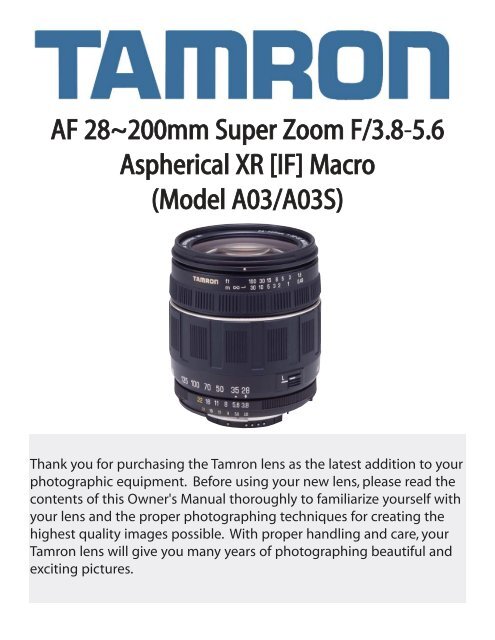
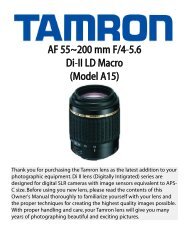

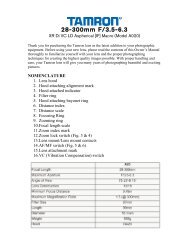
![SP AF 300mm F/2.8 LD [IF] for Canon (Model 360EE) - Tamron](https://img.yumpu.com/27036206/1/190x245/sp-af-300mm-f-28-ld-if-for-canon-model-360ee-tamron.jpg?quality=85)
![SP AF17-50mm F/2.8 XR Di LD Aspherical [IF] - Tamron](https://img.yumpu.com/27036204/1/190x245/sp-af17-50mm-f-28-xr-di-ld-aspherical-if-tamron.jpg?quality=85)
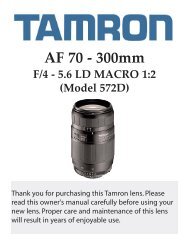
![AF 18~250 mm F/3.5-6.3 Di-II LD Aspherical [IF] - Tamron](https://img.yumpu.com/27036201/1/190x245/af-18250-mm-f-35-63-di-ii-ld-aspherical-if-tamron.jpg?quality=85)
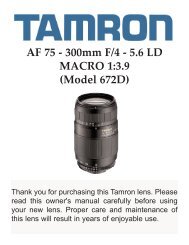
![AF28-300mm F/3.5-6.3 XR Di LD Aspherical [IF] Macro ... - Tamron](https://img.yumpu.com/27036194/1/190x245/af28-300mm-f-35-63-xr-di-ld-aspherical-if-macro-tamron.jpg?quality=85)
![SP AF 14mm F/2.8 Aspherical [IF] (Model 69E) - Tamron](https://img.yumpu.com/27036192/1/190x245/sp-af-14mm-f-28-aspherical-if-model-69e-tamron.jpg?quality=85)

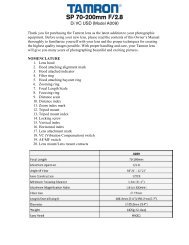
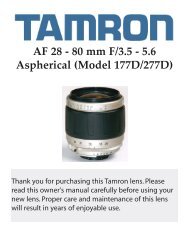
![SP AF 17~50 mm F/2.8 XR Di-II LD Aspherical [IF] (Model ... - Tamron](https://img.yumpu.com/27036181/1/190x245/sp-af-1750-mm-f-28-xr-di-ii-ld-aspherical-if-model-tamron.jpg?quality=85)